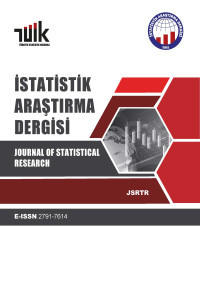Türkiye ve Hong Kong-Çin'deki Öğrencilerin Matematik Öğrenme Stratejileri Modelinin Karşılaştırılması: Çoklu Grup Yapısal Eşitlik Modelleri Yaklaşımı
Çoklu grup yapısal eşitlik modelleri, Ölçme değişmezliği, PISA
Comparison of Mathematics Learning Strategies Models Across Turkey and Hong Kong-China: Multi-Group Structural Equation Modeling Approach
___
- Bagozzi, R. P. 1994. Structural Equation Models in Marketing Research: Basic Principles, in: Principles of Marketing Research, R. P. Bagozzi (ed.). Oxford: Blackwell, pp. 317--385.
- Byrne, B., Watkins, D. 2003. The issue of measurement invariance revisited, Journal of Cross-cultural Psychology, 34,155-175.
- Carmines, E. G., Zeller, R. A. 1979. Reliability and validity assessment, Sage, Beverly Hills, California.
- French, B. F., Finch, W. H. 2008. Multigroup confirmatory factor analysis: Locating the invariant referent sets, Structural Equation Modeling, 15,1, 96- 113.
- Herdman, M., Fox-rushby, J., Badıa, X. 1998. A model of equivalence in the cultural adaptation of HRQOL instruments: The universalist approach, Quality of Life Research, 7,4,323-335.
- OECD, 2004. Learning for Tomorrow's World - First Results from PISA 2003, OECD, Paris.
- OECD, 2005, PISA 2003 Technical Report, Paris.
- Lord F. M., Novick, R. 1968. Statistical theories of mental test scores. Reading MA: Addison-Wesley.
- Mark, B. A., Wan, T. T. H. 2005. Testing measurement equivalence in a patient satisfaction instrument. Western Journal of Nursing Research, 27 (6), 772-787.
- Meade, A. W., Bauer, D. J. 2007. Power and precision in confirmatory factor analytic tests of measurement invariance. Structural Equation Modeling, 14, 611 -635.
- Moraes, C. L, Reichenheim, M. E. 2002. Cross-cultural measurement equivalence of the revised conflict tactics scales (cts2) portuguese version used to identify violence within couples. Cad. Saude PUblica, 18 (3).
- Raykov, T., Marcoulides, G. A. 2006. On Multilevel Model Reliability Estimation From the Perspective of Structural Equation Modeling. Structural Equation Modeling, 13, 130-141.
- Salzberger, T., Sinkovics, R. R., Schlgelmich, B. B. 1999. Data equivalence in crosscultural research: A comparison of classical test theory and gizil trait theory based approaches. Australasian Marketing Journal, 7 (2),23-38.
- Steinmetz, H., Schmid, P., Tina-Booh, A.,Wieczorek, S., Schwartz, S. H. 2009.Testing measurement invariance using multigroup CFA: Differences between educational groups in human values, Quality & Quantity,43(4),599-616.
- Tabachnick, B. G., Fidell, L. S. 2001. Using Multivariate Statistics (4th ed.). Needham Heights, MA: Allyn and Bacon.
- Vandenberg, R. J., Lance, C. E. 2000. A review and synthesis of the measurement invariance literature: Suggestions, practices and recommendations for organizational research. Organizational Research Methods, 3, 4-69.
- Wicherts, J. M., 2007. Group differences in intelligence test performance. Unpublished dissertation, University of Amsterdam.
- ISSN: 1303-6319
- Başlangıç: 2002
- Yayıncı: TÜİK
Umut ARSLAN, Ergun KARAAĞAOĞLU, Orçun ÇİFTÇİ, Necla ÖZER, Barış KAYA
Cox Oransal Hazard Regresyon Modeli ve Trafik Verilerine Uygulanması
Filiz KARDİYEN, Gökhan KAYGISIZ
Uyarlanabilir Küme Örneklemesinde Ön Örneklem Hacmine Göre Etkinlik
Fatma NOYAN, Gülhayat GÖLBAŞI ŞİMŞEK
Türkiye İklim Bölgelerinin Hiyerarşik Kümeleme Yöntemi ile Belirlenmesi
Elçin KARTAL, Cem İYİGÜN, Fidan M. FAHMİ, Ceylan YOZGATLIGİL, Vilda PURUTÇUOĞLU, İnci BATMAZ, Gülser KÖKSAL, Murat TÜRKEŞ
